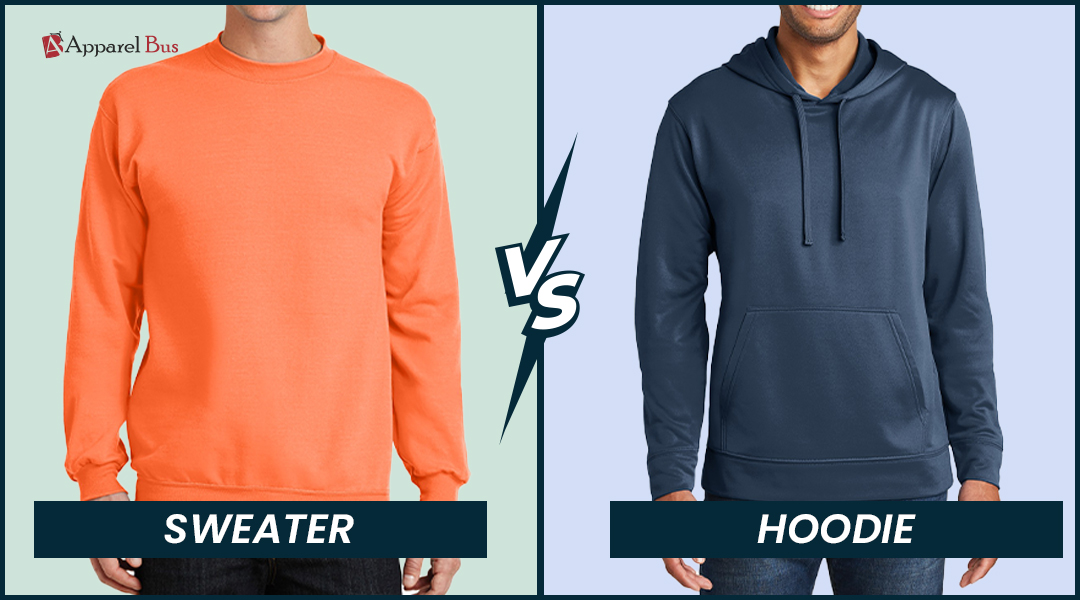Sweater vs Hoodie: Which One Should You Choose for Style and Warmth?
As the weather is getting cold, many people will either wear a warm sweater or a hoodie, both are intended to keep you warm and comfortable. They are designed uniquely and differently for different occasions. In this blog, we are going to have an in-depth conversation about the difference between a hoodie and a sweater based on your needs and specifications. This comparison will help you choose the best wardrobe staple that fulfills your demands and requirements.
What is a Hoodie?
A hoodie is a sweatshirt featuring an attached hood, often with adjustable drawstrings and a front kangaroo pocket. Made from cotton, polyester blends, or fleece, hoodies are designed for casual comfort and practicality. Initially created for workers needing protection from cold and rain, hoodies became a staple of streetwear culture in the 1990s and remain popular for their relaxed style and functionality. Not sure which hoodie suits you best?
Not sure which hoodie suits you best? Explore our types of hoodies guide to help you choose.
What is a Sweater?
A sweater is a knitted garment designed to provide warmth and comfort. They are typically designed from a material like wool, cotton, cashmere, or acrylic sweaters are usually available in different styles like pullovers, cardigans, crew necks, necklines, and turtlenecks.
Sweaters are made of the best quality material that provides immense protection to the farmers and the fishermen. With time, they evolved with beautiful patterns and finer quality fabrics like Merino wool and cashmere, becoming a symbol of sophistication and refinement.
Sweater vs Hoodie: Side-by-Side Comparison
| Feature | Sweater | Hoodie |
| Material | Wool, cotton, cashmere, acrylic (knitted) | Cotton/polyester blends, fleece-lined |
| Design | No hood, fitted or semi-fitted silhouette | Hood with drawstrings, kangaroo pocket |
| Warmth | Excellent insulation with breathability | Thick, cozy fleece for maximum warmth |
| Style | Polished, versatile for casual to semi-formal | Casual, sporty, streetwear vibe |
| Functionality | Ideal for layering, no pockets, or minimal | Hood and pockets provide extra utility |
| Occasions | Work, dinners, formal or casual outings | Casual outings, sports, travel, lounging |
Material:
- Sweater:
Sweaters are typically crafted from knitted materials such as wool, cotton, cashmere, or synthetic yarns like acrylic. The knitting process creates a breathable fabric that traps heat efficiently while allowing airflow, which helps regulate body temperature.
Sweaters come in various weights, from lightweight cotton knits suitable for mild weather to thick wool or cashmere blends designed for colder climates. The natural fibers used in sweaters often provide a more refined texture and appearance compared to hoodies.
- Hoodie:
Hoodies are generally composed of cotton and polyester (usually with soft fleece lining on the interior). This mix forms a thick, fluffy cloth that is warm and comfortable, especially during cold weather and outdoors. Hoodies are therefore best suited when the weather is cold.
The fleece inner provides additional insulating capabilities, managing the heat well, especially in the body, and remains soft on the skin. The cotton-polyester blend is also durable and easy-care since the material does not shrink or fade with time.
Design:
- Sweater:
Sweaters do not have hoods and typically feature a variety of necklines, such as crew neck, V-neck, or turtleneck. They are usually more fitted or semi-fitted, offering a sleek silhouette that works well for layering under jackets or wearing alone for a polished look.
Sweaters can be pullovers or cardigans (which open at the front with buttons or zippers). Their design is generally more classic and versatile, suitable for both casual and semi-formal occasions.
- Hoodie:
The defining feature of a hoodie is its attached hood, which usually comes with adjustable drawstrings to tighten or loosen the fit around the head. This hood offers practical protection against wind, rain, and cold, making hoodies especially functional for outdoor use. Most hoodies also include a large kangaroo pocket at the front, or sometimes two side pockets, providing convenient storage for small items or a place to keep hands warm.
The overall design is relaxed and casual, emphasizing comfort and ease of movement, which makes hoodies popular in sportswear, streetwear, and everyday casual fashion. It’s easy to see why so many people compare a hoodie vs a sweater when deciding what suits their style best.
Warmth:
- Sweater:
Sweaters offer excellent insulation through their knitted fabric, which traps warmth while allowing breathability. They provide a balanced level of warmth that can be adjusted by layering, making them suitable for indoor wear or milder outdoor conditions. Sweaters made from wool or cashmere can be very warm, but generally do not provide the same wind protection as hoodies.
- Hoodie:
Hoodies provide substantial warmth and insulation. The thick material traps heat effectively, making hoodies a great choice for cold, windy, or damp weather. The hood itself adds an extra layer of protection for the head and neck, which is especially useful in outdoor settings. Because of their bulkier construction, hoodies tend to be warmer than most sweatshirts, making them ideal for winter or chilly days.
Style and Use:
- Sweater:
Sweaters have a timeless, versatile style that can be dressed up or down. They are appropriate for work, dinners, casual gatherings, and even semi-formal events when paired with the right accessories and layering pieces. Sweaters can be styled with collared shirts, blazers, skirts, or tailored pants for a refined look.
- Hoodie:
Hoodies are inherently casual and sporty, often associated with streetwear and relaxed fashion. They are perfect for lounging, running errands, outdoor activities, or casual social settings. Hoodies can be paired with joggers, jeans, or shorts, and layered under jackets for a trendy, urban look.
Their bold colors, graphic prints, and relaxed fit make them popular among younger demographics and those seeking comfort without sacrificing style.
When to Wear a Hoodie

- Perfect on a lazy weekend, to run errands, or even to hang out with your friends.
- The hood and pockets are convenient to warm and protect against the wind or light rain.
- Simple and comfortable to wear during working out sessions or travel.
- Combine with joggers, denim, or even under jackets in case of a more modern way of style.
When to Wear a Sweater

- Sweaters go with collared shirts and blazers on office wear or at dinner.
- Sweaters of thin or medium weight are ideal options to wear beneath a coat or a jacket in wintertime.
- A weekend outfit can be chunky with knits or even with skirts.
- Cotton sweaters are lightweight and can be worn in the evening, spring, or autumn.
Which One is Right for You?
Choose a Hoodie if: Comfort and casual style are your priorities, especially for outdoor activities or relaxed settings, and don’t forget to check out wholesale hoodies if you’re buying for a team, business, or group.
Choose a Sweater if: You want a versatile piece that can transition from work to social events with a polished appearance.
Consider stocking up on Sweaters for your seasonal wardrobe.
Conclusion
Sweaters and hoodies are the winter wardrobe staples, and they have their benefits. Sweaters are elegant and versatile, suitable to be dressed up or layered, whereas hoodies are the most comfortable and casual, with excellent practical design, such as hoods and pockets.
It is up to you and what fits your lifestyle, occasion, and personal style preference, but it is good to have both so that you are prepared to face any type of cold-weather situation.







Leave us a comment